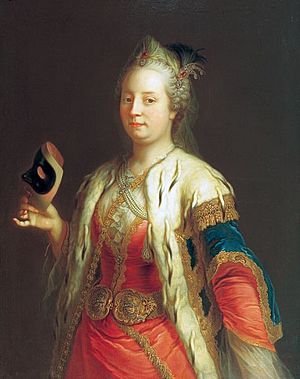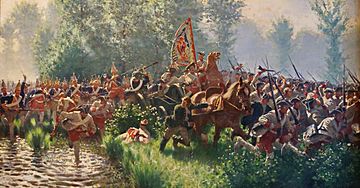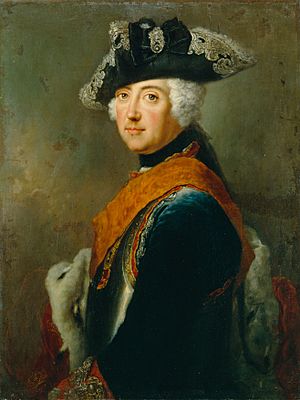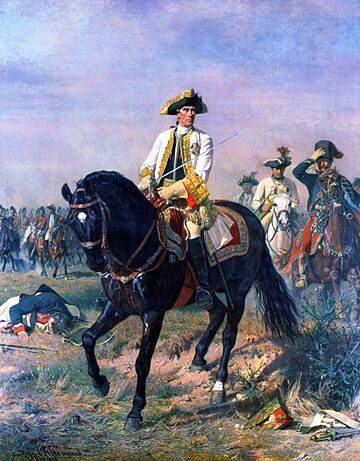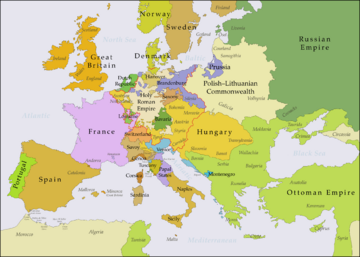Silesian Wars facts for kids
Quick facts for kids Silesian Wars |
|||||||||
|---|---|---|---|---|---|---|---|---|---|
| Part of the Austro-Prussian rivalry | |||||||||
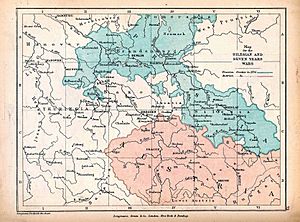 The Central European borders of Brandenburg–Prussia (blue-green) and the Habsburg monarchy (red) in 1756, after Prussia's seizure of Silesia in the First Silesian War |
|||||||||
|
|||||||||
| Belligerents | |||||||||
| Commanders and leaders | |||||||||
The Silesian Wars were three big fights in the mid-1700s. They were between Prussia and Habsburg Austria. Both sides wanted control of a region called Silesia, which is now in Poland.
The First (1740–1742) and Second (1744–1745) were part of a bigger conflict. This was called the War of the Austrian Succession. Prussia joined others to try and gain land from Austria. The Third Silesian War (1756–1763) was part of the worldwide Seven Years' War. In this war, Austria led a group of countries trying to take land from Prussia.
There wasn't one single event that started these wars. Prussia said it had old family claims to parts of Silesia. But other reasons, like power and land control, were also important. Maria Theresa was taking over the Austrian throne. This gave Prussia a chance to become stronger than its neighbors.
All three wars are seen as wins for Prussia. The first war made Austria give most of Silesia to Prussia. After these wars, Prussia became a new strong country in Europe. It was the main Protestant state in Germany. Austria's loss to a smaller German power hurt its reputation. The fight over Silesia showed a bigger rivalry between Austria and Prussia. This rivalry was about who would lead the German-speaking people. It later led to the Austro-Prussian War in 1866.
Contents
Why did the Silesian Wars happen?
In the early 1700s, the ruling family of Prussia, the House of Hohenzollern, claimed parts of Silesia. Silesia was a rich area belonging to the Habsburg family. It was next to Prussia's main land.
Silesia was important for many reasons. It brought in taxes and had many factories. It also provided soldiers. Its location was very important for military reasons. The valley of the Upper Oder river was a natural path for armies. Whoever controlled Silesia could threaten their neighbors. Silesia was also on the edge of the Holy Roman Empire. This allowed its owner to limit the power of Poland and Russia in Germany.
Prussia's old claims to Silesia
Prussia's claims to Silesia came from a treaty made in 1537. This treaty said that some Silesian lands would go to the Hohenzollern family. This would happen if the local ruling family in Silesia died out. But the Habsburg King Ferdinand I did not agree to this.
Later, in 1603, a Hohenzollern ruler inherited another part of Silesia. His son, Johann Georg von Brandenburg, became its duke. During the Thirty Years' War, Johann Georg fought against the Catholic Emperor. After the Emperor won, he took Johann Georg's land. The Hohenzollerns kept saying it was theirs.
In 1675, the Silesian ruling family ended. The Hohenzollerns claimed more lands. But the Habsburg Emperor ignored their claims. In 1685, the Emperor Leopold I gave Prussia a small piece of Silesia. This was in exchange for military help against the Turks. But later, the Emperor took it back. Prussia's King Frederick III then brought up all the old Hohenzollern claims again.
Maria Theresa takes the Austrian throne
Two generations later, a new Prussian king, Frederick II, wanted Silesia. He became king in May 1740. Frederick believed his family's claims were real. He also had a large, well-trained army and a lot of money.
Austria was having money problems. Its army was not strong after a recent war. The situation in Europe was good for attacking Austria. Britain and France were busy fighting each other. Sweden was getting ready for war with Russia. Other German rulers also had claims against Austria.
A chance for Prussia came when the Habsburg Emperor Charles VI died in October 1740. He had no sons. Charles had made a rule called the Pragmatic Sanction of 1713. This rule said his oldest daughter, Maria Theresa, would inherit his titles. When he died, she became the ruler of Austria and other lands. Many countries had agreed to this rule while Charles was alive. But after he died, Prussia, Bavaria, and Saxony quickly challenged it.
How did the armies fight?
Wars in the 1700s used many guns along with swords. Armies had many foot soldiers with muskets and bayonets. Horse soldiers used swords and pistols. Light horse soldiers scouted and sent messages. Heavy horse soldiers were used for big attacks. Cannons helped in battles and were key for attacking forts.
Wars often focused on taking control of important forts. These forts controlled roads and areas around them. Long sieges of forts were common. Big field battles were not as common. But King Frederick liked to fight decisive battles more than others.
Armies were supplied by their governments. They stored supplies in central places. Supply wagons were easy targets for enemies. Armies usually stopped fighting in winter. They would set up winter camps and start fighting again in spring.
The First Silesian War (1740–1742)
After Emperor Charles died, Frederick decided to attack first. On December 11, 1740, he told Maria Theresa to give up Silesia. In return, he offered to protect her other lands. He also offered to pay her money and support her husband for Emperor.
Frederick didn't wait for an answer. He led Prussian troops into Silesia on December 16. This started the First Silesian War. By January 1741, Prussia controlled almost all of Silesia. Austrian strongholds were under attack. A battle at Battle of Mollwitz on April 10 secured Prussia's control.
Other countries saw Austria's defeat. They decided to attack Austria too. This made the conflict bigger, becoming the War of the Austrian Succession. Frederick secretly talked peace with Maria Theresa. They agreed that Austria would give up Lower Silesia for peace.
But Frederick thought Austria wouldn't keep its promise. So, he started fighting again. Prussian forces moved into Moravia. In January 1742, Bavaria's ruler became the new Holy Roman Emperor. Frederick tried to attack Vienna with his allies. But his allies were not helpful, so the plan failed.
An Austrian attack in Bohemia led to the Battle of Chotusitz on May 17. Prussia won, but it was a close fight. This made Austria unable to push its enemies out of Bohemia. New peace talks started. Austria agreed to give most of Silesia to Prussia. This included the County of Glatz. Prussia also agreed to stay neutral in the bigger war. This peace was signed on June 11, 1742, ending the First Silesian War.
The Second Silesian War (1744–1745)
Peace with Prussia helped Austria fight its other enemies. By mid-1743, Austria had taken back Bohemia. It also pushed the French back and took over Bavaria. In September 1743, Britain, Austria, and Savoy–Sardinia made a new alliance. Frederick thought Maria Theresa wanted to take Silesia back. So, on August 7, 1744, Prussia joined the war again. Frederick led his soldiers into Bohemia on August 15, starting the Second Silesian War.
Prussian forces took Prague on September 16. This made the Austrian army leave France and return to Bohemia. The French did not stop the Austrian army from returning quickly. Frederick tried to force a big battle near Prague. But the Austrian general avoided a direct fight. He focused on cutting off Prussian supplies. This made the Prussians leave Bohemia and go back to Silesia in November.
In January 1745, Austria made a new alliance with Britain, Saxony, and the Dutch Republic. The Holy Roman Emperor died on January 20. This removed the main reason for Frederick's alliance. Austria attacked Bavaria again in March 1745. They won a big victory and made peace with Bavaria.
Austria then invaded Silesia. In May, an Austrian–Saxon army entered Silesia. But Frederick surprised and defeated them at the Battle of Hohenfriedberg on June 4. This ended Austria's hope of getting Silesia back right away. The Prussians followed the defeated army into Bohemia. Maria Theresa achieved a major goal when her husband was named Holy Roman Emperor on September 13.
On September 29, the Austrians attacked Frederick's camp. Prussia won the Battle of Soor, even though they were surprised and outnumbered. Soon, low supplies forced the Prussians back into Silesia for winter. In November, Austria and Saxony planned to invade Brandenburg. They hoped to take Berlin and end the war. On November 23, Frederick surprised the Austrians at the Battle of Hennersdorf. Another Prussian army defeated the main Saxon army on December 15. The Prussians then took Dresden.
In Dresden, both sides quickly made a peace treaty. Maria Theresa agreed that Prussia would keep Silesia and Glatz. Frederick recognized Francis I as Holy Roman Emperor. Saxony had to pay Prussia a lot of money. The borders stayed the same as before the war. This was Prussia's main goal. The Treaty of Dresden was signed on December 25, 1745. This ended the Second Silesian War.
What happened between the wars?
After Prussia left the war, the bigger War of the Austrian Succession continued. It ended in 1748. Maria Theresa still did not fully accept Prussia's control of Silesia. Frederick also did not fully accept Maria Theresa's rule in Bohemia. The main problem over Silesia was not solved. Both sides spent the years of peace getting ready for more fighting.
Prussia built new forts in Silesia. Its army got heavier cannons. The government saved money for future wars. Frederick worked to keep his alliance with France. He also tried to make Britain feel safe about Hanover. He wanted to control the Austrian threat and keep things balanced.
After the war, Maria Theresa started big changes in Austria. She reformed the government and the army. Her minister improved the tax system. This helped pay for a bigger army. An Austrian general improved the army's training, like Prussia's army. In 1746, Maria Theresa made a defense agreement with Empress Elizabeth of Russia. This joined them against Prussia. From 1753, Austria's foreign minister worked to become friends with France. France had been Austria's old enemy. In 1756, Austria left its alliance with Britain. It made a new alliance with France. Prussia and Britain then made their own alliance. This big change in alliances was called the Diplomatic Revolution.
The Third Silesian War (1756–1763)
Austria, France, and Russia formed a new group against Prussia. Frederick believed Prussia would be attacked in early 1757. So, he attacked first on August 29, 1756. He invaded Saxony. This started the Third Silesian War. As allies joined, the fight quickly became the big Seven Years' War across Europe.
Prussia took Saxony in late 1756. They moved into Bohemia in early 1757. They won battles and reached Prague. In May, Prussians pushed back Austrian defenders at the Battle of Prague. They suffered many losses. Then they surrounded the city. An Austrian counter-attack led to a big Austrian win at the Battle of Kolín on June 18. This pushed the Prussians completely out of Bohemia. Meanwhile, Russia and Sweden attacked Prussia from the east and north.
In late 1757, French forces tried to take Saxony back. But they lost badly at the Battle of Rossbach on November 5. This kept Saxony under Prussian control. It also made France less willing to fight in the Silesian War. Another Austrian army invaded Silesia. But it was defeated at the Battle of Leuthen on December 5. Prussia then got back control of almost all of Silesia. Over winter, a Prussian-Hanoverian army pushed the French out of Westphalia. This made Prussia's western side safe for the rest of the war.
In mid-1758, Prussia invaded Moravia. They surrounded the city of Olmütz. But the city was well defended. By late June, the Prussians ran out of supplies. Austrians destroyed a major Prussian supply convoy on June 30. The Prussians stopped their attack and went back to Silesia. Russian forces moved into East Prussia. They fought the Prussians to a costly tie at the Battle of Zorndorf on August 25. An Austrian army in Saxony made little progress.
In 1759, Austrian and Russian forces joined up. They defeated Prussia badly at the Battle of Kunersdorf on August 12. But the winners did not chase the Prussians or take Berlin. Frederick thought the war was lost after Kunersdorf. But the allies had problems and didn't act quickly. This gave Prussia another chance. Frederick called it the "Miracle of the House of Brandenburg". In the next months, Austrians took back Dresden and most of Saxony.
In 1760, Austrians moved into Silesia. The armies moved around for a while. Then they fought at the Battle of Liegnitz on August 15. Prussia won, stopping the Austrian advance. In late 1760, Russians and Austrians briefly took Berlin. On November 3, the main armies fought the Battle of Torgau. Prussia won, but both sides lost many soldiers. In 1761, there was little fighting. But Russian forces moved closer to Berlin.
In January 1762, Austria's ally Russia suddenly left the war. Empress Elizabeth died. Her successor, Peter III of Russia, liked Prussia. He immediately pulled his armies out and made peace with Prussia. Peter was overthrown and killed within months. But by then, the war had turned in Prussia's favor. Russia did not start fighting again. Both sides were very tired. Peace talks began in late 1762. They agreed to go back to the way things were before the war. This confirmed Prussia's control of Silesia. This was in the Treaty of Hubertusburg in February 1763. Prussia also agreed to support Maria Theresa's son as the next Holy Roman Emperor.
What were the results of the wars?
The Silesian Wars ended with Prussia winning against Austria. Everyone at the time thought this, and historians still agree. Prussia took a land that Austria had held for a long time. The results of the second and third wars confirmed this. These wars changed how countries in Europe worked together. They started a rivalry between Austria and Prussia. This rivalry shaped German politics for a hundred years.
Prussia's new power
Prussia's win made it stand out from other German rivals. It showed Prussia was becoming a major European power. It was also the leading Protestant power in Germany. Prussia gained about 35,000 square kilometers of new land. It also gained about a million new people in Glatz and Silesia. This area was busy with factories and people. It would provide many soldiers and taxes for Prussia.
Silesia also gave Prussia a strong position against Saxony and Austria. It helped protect Prussia from being surrounded. King Frederick's reputation grew greatly from his wins. He became known as "Frederick the Great." People forgot how much he owed to luck (Russia changing sides) and British money. They remembered his strong leadership and smart battle plans. His small kingdom had beaten Austria and defended its prize against many strong countries. This seemed amazing to people at the time.
However, the wars also hurt Prussia's economy and population. Much of Frederick's later rule was spent fixing the damage. The government encouraged Protestants from Catholic lands to move to Prussia. This helped make up for population losses. The wars caused money problems and economic trouble. After the wars, the government helped control food prices. It also started a basic welfare system for soldiers who were hurt or poor.
Prussia's army lost many soldiers and officers. After the peace, the country didn't have enough money or people to rebuild the army fully. In later wars, the Prussian army did not fight as well. It was badly beaten by Napoleon's army in 1806. Only after big changes did Prussia's military power start to grow again.
Changes in Austria
Losing the Silesian Wars cost Austria its richest province. Giving in to a smaller German prince also hurt the Habsburg family's pride. Prussia becoming a strong power was a long-term threat to Austria's leadership in Germany. But Maria Theresa did get Prussia to support her husband and son for Holy Roman Emperor. This kept her family's main title, even if it was less than she hoped for.
Losing to Prussia made Austria want to change a lot. This led to the first wave of "Theresian reforms." These were big changes to Austria's government and army. They also completely changed Austria's foreign policy.
After the disappointment of the Third Silesian War, more reforms happened. In 1761, Austria made new central government bodies. This helped make decisions faster. In the 1760s and 1770s, they worked hard to collect more taxes. This greatly increased government money. In 1766, the first common law code was created. This helped make laws the same across the empire. Maria Theresa also made rules to limit forced peasant labor. Her son continued this with his own rules. The government also started required primary education. It set up public schools. These steps began big efforts to modernize Austria.
See also
- Wars and battles involving Prussia
- Imperial Army (Holy Roman Empire)
- Prussian Army



